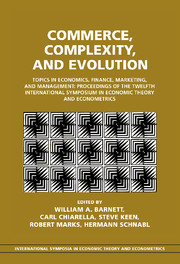 Commerce, Complexity, and Evolution
Commerce, Complexity, and Evolution Book contents
- Frontmatter
- Contents
- Series editor's preface
- Volume editors' preface
- Editors
- List of contributors
- I Philosophical and methodological implications of complexity and evolution in economic systems
- II Finance and the macroeconomy
- III Market and sectoral dynamics
- IV Marketing and interdependent behavior
- 15 A complex-systems simulation approach to evaluating plan-based and reactive trading strategies
- 16 Genetic algorithms and evolutionary games
- 17 Evolved perception and the validation of simulation models
- 18 The application of cellular-automata and agent models to network externalities in consumers' theory: a generalization-of-life game
16 - Genetic algorithms and evolutionary games
Published online by Cambridge University Press: 05 December 2011
- Frontmatter
- Contents
- Series editor's preface
- Volume editors' preface
- Editors
- List of contributors
- I Philosophical and methodological implications of complexity and evolution in economic systems
- II Finance and the macroeconomy
- III Market and sectoral dynamics
- IV Marketing and interdependent behavior
- 15 A complex-systems simulation approach to evaluating plan-based and reactive trading strategies
- 16 Genetic algorithms and evolutionary games
- 17 Evolved perception and the validation of simulation models
- 18 The application of cellular-automata and agent models to network externalities in consumers' theory: a generalization-of-life game
Summary
The 2-player iterated prisoner's dilemma (2IPD) game is a 2 x 2 non-zero-sum noncooperative game, in which non-zero sum indicates that the benefits obtained by a player are not necessarily the same as the penalties received by another player, and noncooperative indicates that no preplay communication is permitted between the players (Colman 1982, Rapoport 1966). It has been widely studied in such diverse fields as economics, mathematical game theory, political science, and artificial intelligence.
In the prisoner's dilemma, each player has a choice of two operations: either cooperate with the other player, or defect. Payoff to both players is calculated according to Table 16.1. In the iterated prisoner's dilemma (IPD), this step is repeated many times and each player can remember previous steps.
Although the 2IPD has been studied extensively for more than three decades, there are many real-world problems, especially many social and economic ones, that cannot be modeled by the 2IPD. Hardin (1968) described some examples of such problems. More examples can be found in Colman's book (1982, pp. 156-159). The N-player iterated prisoner's dilemma (NIPD) is a more realistic and general game that can model those problems. In comparing the NIPD with the 2IPD, Davis et al. (1976, p. 520) commented that
“[t]he N-player case (NPD) has greater generality and applicability to real-life situations. In addition to the problems of energy conservation, ecology, and overpopulation, many other real-life problems can be represented by the NPD paradigm.”
Colman (1982, p. 142) and Glance and Huberman (1993, 1994) have also indicated that the NIPD is “qualitatively different” from the 2IPD and that “… certain strategies that work well for individuals in the Prisoner's Dilemma fail in large groups.”
- Type
- Chapter
- Information
- Commerce, Complexity, and EvolutionTopics in Economics, Finance, Marketing, and Management: Proceedings of the Twelfth International Symposium in Economic Theory and Econometrics, pp. 313 - 334Publisher: Cambridge University PressPrint publication year: 2000
- 5
- Cited by
